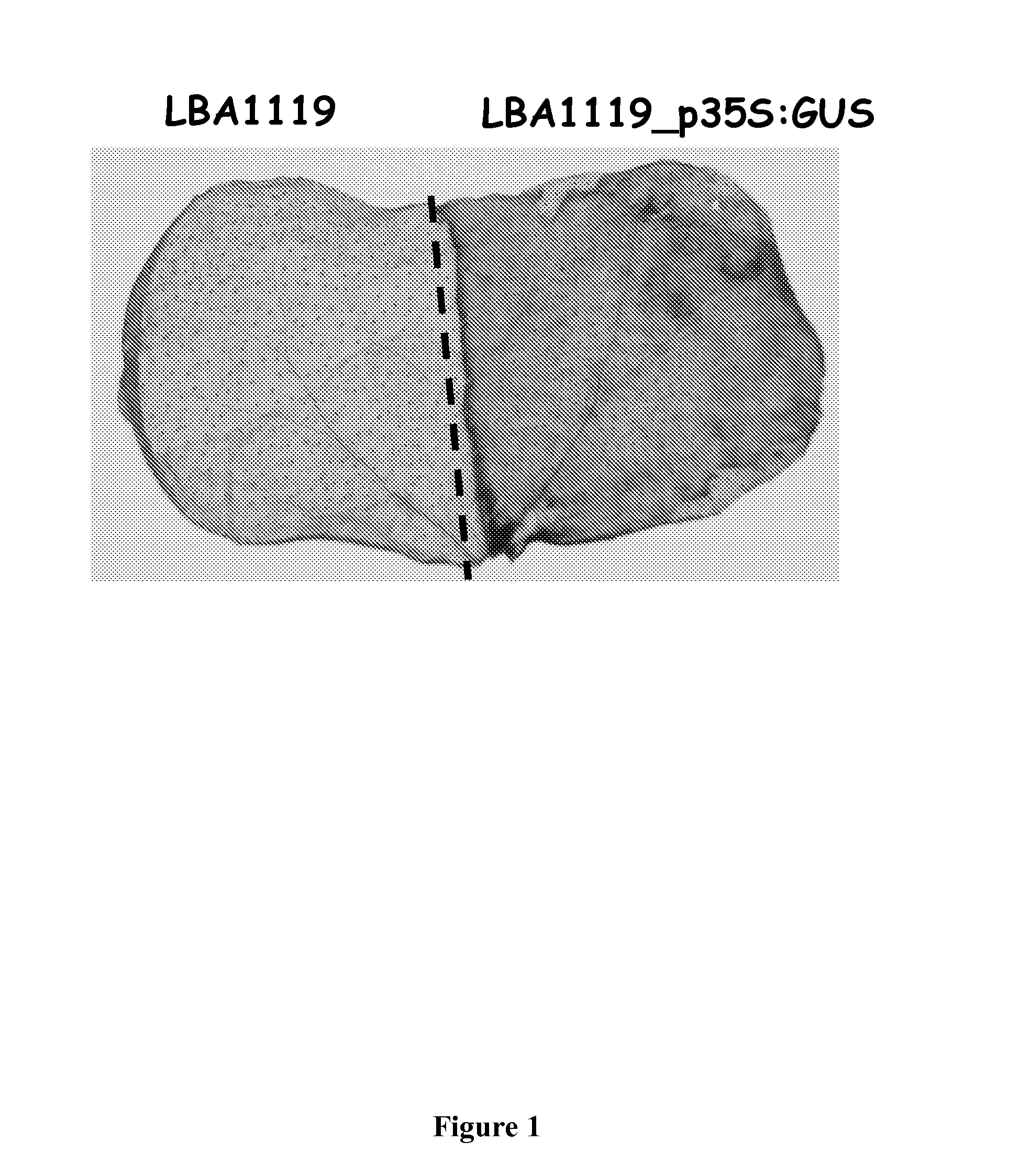Overproduction of jasmonic acid in transgenic plants
a technology of jasmonic acid and transgenic plants, applied in the field of plant diseases, can solve the problems of limited action spectrum, high cost, and general association of chemical industry molecules with pollution problems and potential risks for animal and/or human health, and achieve the effects of improving resistance to pathogenic agents, increasing jasmonic acid level, and increasing resistan
- Summary
- Abstract
- Description
- Claims
- Application Information
AI Technical Summary
Benefits of technology
Problems solved by technology
Method used
Image
Examples
example 1
Transformation of a Cotton Plant
[0110]The Agrobacterium tumefaciens strain LBA1119 has been used to transitorily transform a cotton plant. The transformation system used is called “ternary”. For numerous plant species, this system causes an increase in the frequency of T-DNA transfer (Van der fits et al., Plant Mol. Biol., 2000, 43: 495-502). Briefly, after contact between the agrobacterium and wounded plant cells, phenolic compounds, oses and an acid pH created an environment that favored the induction of the genes vir. The transcription factor VirG activated by phosphorylation can induce the expression of the vir genes which is necessary to the transfer of T-DNA. The ternary system used a mutated form of the virG protein (virGN54D) which mimics the active form.
[0111]This system was introduced in the agrobacterium strain LBA1119. This strain also possesses one of the four following binary vectors: pCAMBIA1300-GUS-intron and pCAMBIA1300-ORA47, pMDC32-ORA47 and pMDC32-GFP. The strain...
example 2
ORA47 Overexpression Increases Endogenous Levels of OPDA and of Jasmonic Acid in Cotton Plants
[0114]OPDA and Jasmonic Acid Extraction.
[0115]First, the vegetal material obtained from a transformed cotton plant was finely ground using a mortar in liquid nitrogen, and 250 mg of the powder obtained were placed in a 1.5 mL-Eppendorf tube. Methanol (1 mL) was added to the powder as were 100 ng of deuterated jasmonic acid (d6Ja) and 100 ng of deuterated OPDA (d50PDA), which served as internal controls. The methanolic extract was then centrifuged at 5000 g for 10 minutes at 4° C. and the supernatant was recovered in glass tubes. This extraction step was repeated three times and the methanolic extracts were combined. The methanol was then eliminated by evaporation under nitrogen (40° C. for 1 to 1.5 hours). The dried residues obtained were taken up with 5 mL of phosphate buffer (phosphate sodium 100 mM, pH 7.8, NaCl 5%). An extraction was then performed on the aqueous extract using 2.5 mL of...
example 3
ORA47 Overproduction in Cotton Plants Increases the Expression of Genes Involved in the Biosynthesis of Jasmonic Acid
[0121]tRNA Extraction.
[0122]Inverse transcription and quantitative real-time PCR (qPCR) analyses were performed using the samples that were prepared for the dosage of OPDA and jasmonic acid (see Example 2).
[0123]The qPCR method used was based on the detection and quantitation of a fluorescent reporter whose emission was directly proportional to the quantity of amplicons generated during the reaction. The qPCR reactions were controlled using the thermocycler MX 3500P (Stratagene, US). The detection system used SYBR Green, which binds to double stranded DNA. The quantitation of transcripts was performed using the Ct (THRESHOLD CYCLE) value, which is defined as being the threshold cycle and which is always present during the exponential phase. The more matrices are to be amplified, the higher is the Ct.
[0124]The primers used were designed using the software Beacon Design...
PUM
| Property | Measurement | Unit |
|---|---|---|
| OD | aaaaa | aaaaa |
| OD | aaaaa | aaaaa |
| OD | aaaaa | aaaaa |
Abstract
Description
Claims
Application Information
 Login to View More
Login to View More - R&D
- Intellectual Property
- Life Sciences
- Materials
- Tech Scout
- Unparalleled Data Quality
- Higher Quality Content
- 60% Fewer Hallucinations
Browse by: Latest US Patents, China's latest patents, Technical Efficacy Thesaurus, Application Domain, Technology Topic, Popular Technical Reports.
© 2025 PatSnap. All rights reserved.Legal|Privacy policy|Modern Slavery Act Transparency Statement|Sitemap|About US| Contact US: help@patsnap.com



